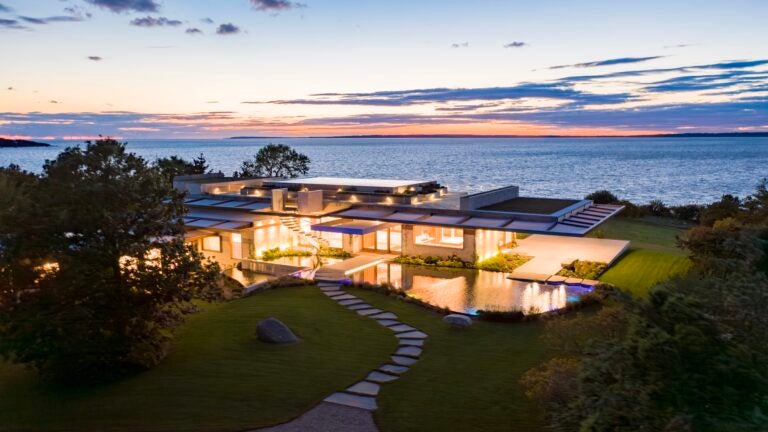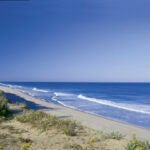Some U.S. homeowners are shunning chlorine and dipping their toes in natural swimming pools
US homeowners dip their toes into the world of natural, chemical-free fun, opting for designs that shun chlorine and shock for plants or special filters.

Now that summer is here, is that hot, balmy weather making you imagine how sweet it would be to have a backyard pool – your own private oasis for entertaining friends, splashing around with the kids, relaxing on an inflatable float, or doing some laps for a cardiac workout? But if you’re planning to build a pool, you’ll need to make an important decision upfront: traditional or au naturel?
Most homeowners are familiar with the traditional chlorinated pool, as well as the weekly (at least) maintenance associated with it. That clear, sparkling water doesn’t just appear magically — it’s the result of adding and monitoring water-balancing chemicals to ensure the perfect pH, alkalinity, and sanitizer levels. And don’t forget checking the filters, skimming, and vacuuming to get rid of debris, as well as shocking the pool with chlorine to eliminate contaminants, such as bacteria and algae.
But some homeowners don’t want to immerse their bodies in all those chemicals, preferring a more natural approach. For them, a natural swimming pool (NSP) is a great option.
“Whether they’ve just bought an electric car or a green roof, the people interested in a natural pool already have some sense of awareness that chemical pools are not sustainable,’’ said Allen Schnaak, co-owner and vice president of BioNova Natural Pools and a member of the board of the Association for Swimming Ponds and Natural Swimming Pools. “It’s all about health, wellness, and green living.’’
A natural pool is simply an engineered swimming pool that has a biological filter adapted to it. It operates without the use of chemicals, instead relying only on biological processes. There are two types of NSPs, according to Schnaak:
BioSwimPonds are pools purified by a wetlands regeneration zone. These pools use aquatic plants and beneficial microbes to control algae and clean the water. They resemble natural ponds and have a separate planted zone.
BioPools are purified by a biological filtration system that does not utilize plants. Instead, a biofilm filter is used to clean the water. These pools resemble traditional swimming pools and require less space than a BioSwimPond.
NSPs currently represent a tiny percentage of the pools constructed nationwide. Schnaak said that while about 16 percent of pools in Europe are natural, they make up only about 0.03 percent of them in the United States. But there are regional differences.
Jesse Dutra, owner of Nantucket Pools, said that of the 10 pools he’s building this year, two are NSPs.
“I don’t sell a natural pool to everybody,’’ he said. “There are times when I see that the person is not going to be interested either because the property doesn’t fit it or the landscape design doesn’t fit it or it’s just not that type of person.”
‘If you don’t like the color green, and you don’t like bugs, then maybe a natural pool isn’t for you.’
— JESSE DUTRA, Nantucket Pools
Pulitzer-prize winning novelist Geraldine Brooks installed a natural pool at her home on Martha’s Vineyard about 10 years ago. It took three months to construct the pool, which includes a swimming area of 700 square feet and regeneration zones of 400 square feet. The pool cost $180,000 to construct; today, it would be about $250,000, said Dutra, who built the pool.
The swimming area resembles a traditional pool, with a beach entry and steps, but there are adjacent water gardens. “There’s a deep lily pond separate from the pool but connected to it, and the water from the pool flows into the water gardens and the lily pond for cleaning,’’ Brooks said. “I love to garden, and what you get with a natural pool is an aquatic garden you can swim in.’’
Brooks said most of her property is within a wetland buffer zone, so she wanted to avoid a pool that used chemicals that might leach into the ground water. “I had seen a natural swimming pool and thought they were absolutely beautiful,’’ she said. “We created a habitat because we planted native water plants, and that has advantages for the bird life and the dragonflies. They love this native water garden, so it adds, rather than takes away from, the natural environment.’’
NSPs generally require less maintenance than chlorine-dependent pools. In 2020, Steven Magoun, a technology executive, installed an 18-foot by 30-foot natural pool at his home in Rye, N.H., for about $110,000. “You only have to balance the pH, and it’s very easy to care for by just dropping a robot vacuum in about once a week,’’ he said. “The water color goes through natural cycles, from crystal clear to a little greenish. Some may not like that it isn’t totally clear all the time. But it’s much nicer to swim in, like in a pond versus all the chlorine.’’

Despite their advantages, NSPs come at a premium. Dutra said that while a typical 16-by-32-foot traditional pool costs $100,000 to $150,000, an NSP with a similar-sized swimming area would run $150,000 to $200,000.
Those considering an NSP should do their due diligence to find a competent, experienced pool builder – check out the website of the Pool & Hot Tub Alliance for a searchable database of its members — and then engage a natural pool designer to design and integrate the filtration system.
You’ll need to be patient, though. Schnaak said supply-chain disruptions have led to backlogs with all types of pool construction, so plan on enjoying your new natural pool in 2024.
Robyn A. Friedman has been writing about real estate and the home market for more than two decades. Follow her @robynafriedman. Send comments to [email protected]. Subscribe to our free real estate newsletter at pages.email.bostonglobe.com/AddressSignUp. Follow us on Twitter @GlobeHomes.







Conversation
This discussion has ended. Please join elsewhere on Boston.com